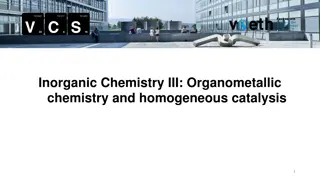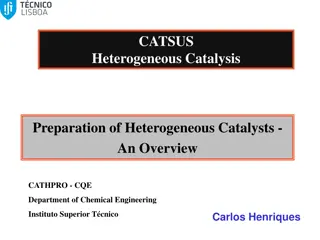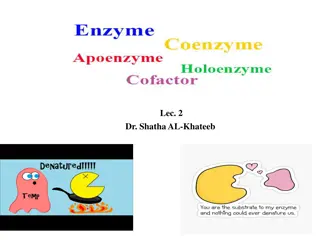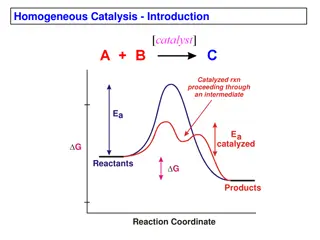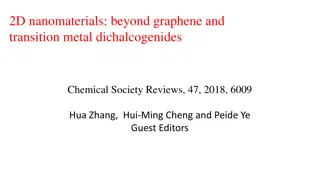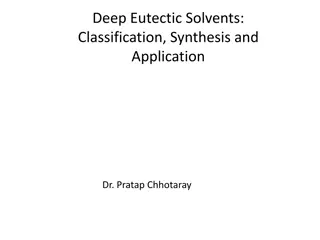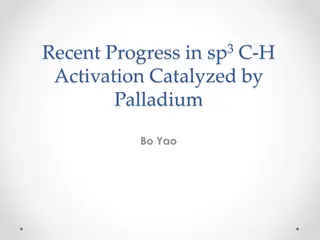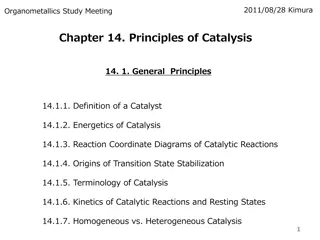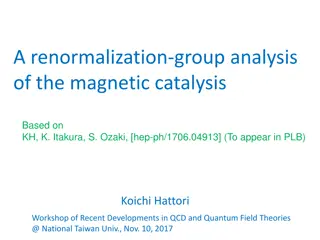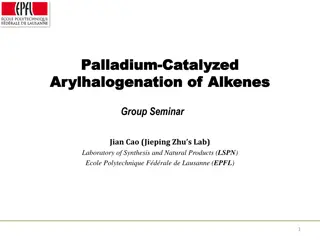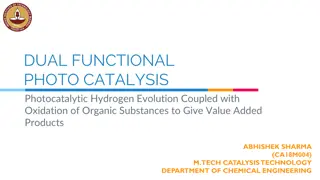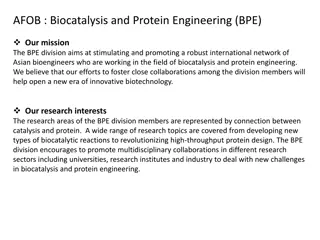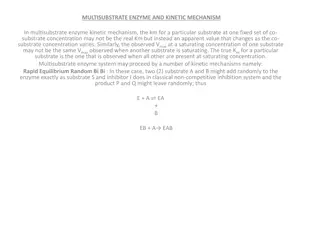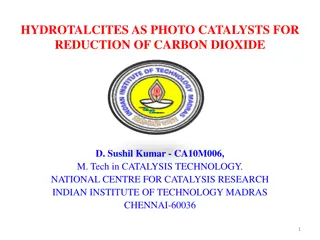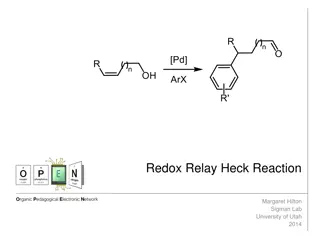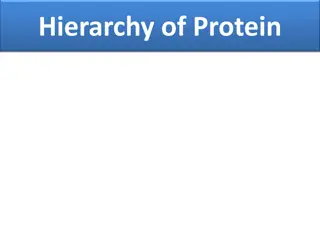Understanding Enzyme Function Through Induced Fit Model
The learning content discusses enzymes as biological catalysts that increase reaction rates by lowering activation energy. It explores how enzyme activity efficiency is influenced by factors such as temperature, pH, and substrate concentration. The Induced Fit Model is analyzed to explain how enzyme
5 views • 12 slides
Organometallic Chemistry III: Transition Metal Complexes and Homogeneous Catalysis
Explore the reactivity of transition metal complexes, including bond metatheses and various reactions. Learn about orbital considerations, synthesis, and spectroscopic properties of organometallic complexes. The course covers basics from AC1, focusing on ligands, electron counting, and MO diagrams.
5 views • 8 slides
Overview of Heterogeneous Catalysis and Catalyst Preparation
The development of catalytic processes involves research and development of new catalysts for better activity, selectivity, and stability. This study focuses on preparing new catalysts, determining their properties, and optimizing their development through structure-reactivity relationships. Catalys
5 views • 17 slides
Principles of Green Chemistry: Catalysis and Bio-Catalysis
The 9th Principle of Green Chemistry emphasizes the use of catalysis to improve reaction efficiency and reduce waste generation. Catalytic reagents enhance selectivity, reduce energy consumption, and minimize the need for stoichiometric reagents. Green catalysis, especially bio-catalysis using enzym
0 views • 25 slides
Factors Affecting Enzyme Activity and Catalysis
Enzyme activity is influenced by various factors such as enzyme concentration, temperature, pH, substrate concentration, inhibitors, activators, and physical agents. The rate of enzyme-catalyzed reactions is directly proportional to enzyme concentration, and temperature plays a significant role with
0 views • 23 slides
Understanding Enzyme Function: The Key Steps and Importance of Cofactors
Enzymes play a crucial role in catalyzing biochemical reactions by forming enzyme-substrate complexes and facilitating changes in substrate molecules to product molecules. The process involves four steps: proximity of enzyme and substrate, binding at the active site, catalysis leading to substrate a
0 views • 39 slides
Understanding Enzyme Catalysis and Active Site Role
Enzymes play a crucial role in catalyzing biochemical reactions by stabilizing transition states through their active sites. Different mechanisms like acid-base, covalent, metal, and electrostatic interactions are employed for stabilization. Acid-base catalysis involves acceleration without being co
1 views • 21 slides
Understanding Homogeneous Catalysis and Its Advantages
Homogeneous catalysis involves catalyzed reactions proceeding through an intermediate with lower activation energy. This method offers advantages such as selectivity, activity, ease of study, and modification but can be sensitive to deactivation. Comparing with heterogeneous catalysts prevalent in i
1 views • 14 slides
Advancements in 2D Nanomaterials Research
Advancements in the field of 2D nanomaterials, beyond graphene and transition metal dichalcogenides (TMDs), have attracted significant attention. Researchers explore various 2D materials with unique properties and applications. The categorization of 2D materials into layered and non-layered structur
0 views • 21 slides
Inorganic Pharmaceutical Chemistry: Applications and Importance
Inorganic pharmaceutical chemistry explores the study of elements and compounds excluding carbon, with diverse applications in pharmacy. It encompasses the synthesis and use of inorganic compounds in drug development, catalysis, pigments, and agriculture. The field also delves into the medicinal val
1 views • 6 slides
Deep Eutectic Solvents: Classification, Synthesis, and Applications
Deep Eutectic Solvents (DES) are versatile solvents formed by mixing specific acids and bases. These solvents exhibit unique hydrogen bonding properties, resulting in a lower melting point compared to individual components. DES can be classified into hydrophobic and hydrophilic types, each with dist
3 views • 7 slides
Advances in sp3C-H Activation Catalyzed by Palladium - Bo Yao
Recent progress in the field of sp3C-H activation catalyzed by palladium has led to significant insights and challenges. Concepts related to C-H activation, strategies employed, and identified obstacles are discussed, highlighting the importance of this area in catalysis research.
0 views • 15 slides
Fundamentals of Asymmetric Catalysis: Energetics and Principles
Exploring the principles and energetics of asymmetric catalysis, this study delves into the importance, classes of transformations, stereoselectivity, and transmission of asymmetry. It discusses reaction coordination diagrams, transition state stabilization, and the terminology of catalysis. The Cur
2 views • 20 slides
Biology Review: Genetics, Enzymes, and Cell Division
Explore key concepts in AP Biology, including genetic continuity and change, enzyme catalysis, mitosis, and meiosis. Understand the mechanisms of genetic variability and cell division processes. Dive into enzyme-substrate interactions and the differences between mitosis and meiosis.
0 views • 11 slides
Renormalization Group Analysis of Magnetic Catalysis in Quantum Field Theories
Explore the phenomenon of magnetic catalysis in strong magnetic fields through a renormalization group analysis, drawing parallels to superconductivity and dimensional reduction. Discuss the impact of IR dynamics on nonperturbative physics like superconductivity. Delve into Landau-level quantization
0 views • 21 slides
Palladium-Catalyzed Arylhalogenation of Alkenes: Seminar Highlights
Seminar conducted by Jian Cao from Jieping Zhu's Lab at EPFL on the topic of Palladium-Catalyzed Arylhalogenation of Alkenes, covering Pd(II)/Pd(IV) and Pd(0)/Pd(II) catalytic cycles, stereochemical studies, historical development, and comprehensive research findings.
0 views • 42 slides
Dual-Functional Photo Catalysis: Hydrogen Evolution & Organic Oxidation
The research explores dual-functional photo catalysis, combining hydrogen evolution with the oxidation of organic substances to produce value-added products. It focuses on utilizing photoelectricity to create electrons for hydrogen production and organic molecule oxidation. The study investigates th
0 views • 14 slides
Asian Bioengineers Network for Biocatalysis and Protein Engineering
The Biocatalysis and Protein Engineering (BPE) division of AFOB aims to build a strong international network of Asian bioengineers working in biocatalysis and protein engineering. Their research areas span catalysis and protein connections, from developing new biocatalytic reactions to high-throughp
0 views • 4 slides
Understanding Multisubstrate Enzyme Kinetic Mechanisms
In multisubstrate enzyme kinetic mechanisms, the apparent Km and Vmax values change with varying substrate concentrations. Different kinetic mechanisms like rapid equilibrium Bi Bi and ordered Bi Bi reactions can occur. The ping-pong Bi Bi reaction involves oscillation between enzyme forms. Various
0 views • 11 slides
Utilizing Hydrotalcites as Photo Catalysts for Carbon Dioxide Reduction
Burning fossil fuels leads to CO2 emissions, posing a significant environmental challenge. Converting CO2 into valuable hydrocarbons through photocatalytic reduction using solar energy provides a sustainable solution. This process involves multi-electron transfer steps, requiring efficient catalysts
0 views • 24 slides
Understanding the Redox-Relay Heck Reaction in Organic Synthesis
The Redox-Relay Heck Reaction is a powerful tool in organic synthesis that allows for the functionalization of olefins with aryl groups. Developed by Sigman and colleagues, this reaction involves a palladium-catalyzed relay controlled by a thermodynamic sink, leading to the formation of aldehydes or
0 views • 6 slides
Overview of Organometallic Compounds in Chemistry
Metalorganic and organometallic compounds play vital roles in organic chemistry, showcasing unique characteristics and diverse applications. From the pioneering discoveries of Cadet's fuming liquid to modern palladium-catalyzed reactions like Heck and Suzuki coupling, this field has continually evol
0 views • 18 slides
Understanding the Hierarchy of Protein Structure
To understand proteins' final shape and function, one must grasp the primary, secondary, tertiary, and quaternary structure levels. Proteins, composed of amino acids, fold into various shapes crucial for their roles such as signaling, catalysis, and structure. The primary structure represents the am
0 views • 28 slides

